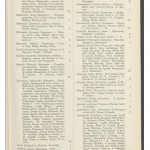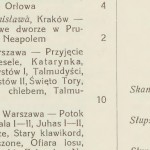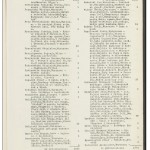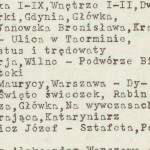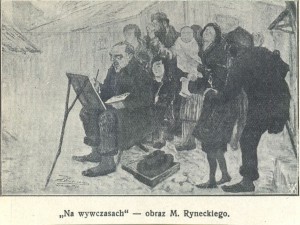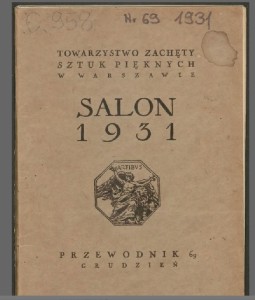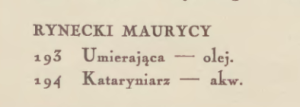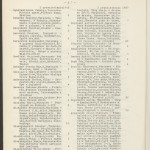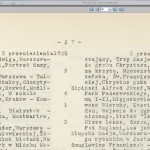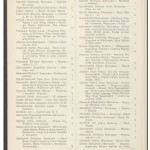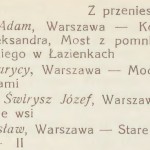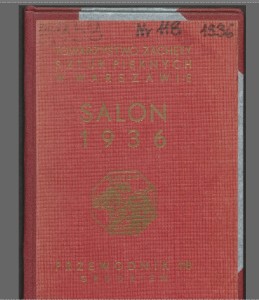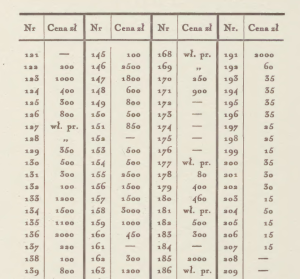[note: updated multiple times, most recently in March 2016]
I recently received an email from Logan Kleinwaks (who runs the absolutely incredible Genealogy Indexer site) with information that he’d recently added several reports from the Warsaw Society for the Encouragement of Fine Arts to his site and that in 3 of the reports he’d digitized and made searchable, there were references to my great-grandfather. While the fact that Moshe (Maurycy) Rynecki had his work shown at this venue is not news, what is really fascinating about these reports is that they share the titles of his exhibited pieces. I’ve flipped through the digital pages of these reports and while I don’t know Polish, much of the document looks like some sort of year end report to members about the status of the organization.
For each of the records about my great-grandfather, I’ve transcribed the titles of each of his works listed and tried to use Google Translate for an English language title. Some titles are easier to understand than others. Sadly, there are no images with the report, so while the titles are often descriptive of each of the paintings, it’s impossible to know the status of each of the works (i.e. Did the piece survive the war? If so, where is it?). To the right of each entry is a number. I believe this is the total number of paintings each artist displayed.
Here are the three pages with indexing information about my great-grandfather, along with a transcription [I’m sorry for the lack of Polish accent marks!] of the painting titles, and a translation (if google translate made sense). If you have translation edits, please let me know. [NOTE: I think I am now all set on translation edits! A really big thank you to Samantha Spalling, Marianka Natanson, and Ed Mitukiewicz for translation insight and help!]
1930 Warsaw Society for the Encouragement of Fine Arts Report
Rynecki, Maurycy, Warszawa –
Przyjęcie Nowożeńców [Reception of the Newlyweds]
Wesele [Wedding]
Katarynka [Barrel organ – as used by an organ grinder]
W szkole talmudystow I [Talmudic School I]
Talmudysci [Talmudists]
W szkole talmudystow II [Talmudic School II]
Święto Tory [Celebration of the Torah (Simchat Torah (?)]
W boznicy [In the synagogue]
Za Chlebem [it means “to go in search of bread” and refers to emigration for economic reasons. I am also told “it may refer to any form of economic migration in search of some paid work (…not necessarily an out-of-the-country emigration although more often than not that was actually the case…). Incidentally, “Za Chlebem” happens to be a title of a popular 19th century novel about Polish peasants emigrating to the US – written in 1880 by Henryk Sienkiewicz, who received Nobel Prize for Literature in 1905, and ever since a mandatory reading for most Polish schoolchildren.”]
Talmudysci [Talmudists]
1931 Warsaw Society for the Encouragement of Fine Arts Report
Rynecki Maurycy, Warszawa –
Dybuk [The Dybbuk]
Swieto swieczek [Feast of Candles (Perhaps a reference to Hanukkah?)]
Rabin Naucza [Rabi is Teaching]
Głowka [Little head (perhaps the portrait of a child?)]
Na Wywczasach [pre-war spelling of Na wczasach, meaning, on holiday or on vacation]. I assume it is this piece whose whereabouts are unknown:
Umierajaca [Dying woman]*
Kataryniarz [Organ-grinder]*
* Both Dying woman and Organ-grinder are also listed in Przewodnik / Towarzystwo Zachęty Sztuk Pięknych w Warszawie. 1931 nr 69 (grudzień) [Guidebook/ Zachęta Society in Warsaw, No 69, December 1931] p. 35
[note: Special thanks to Piotr Nazaruk who made this discovery in the Mazovian Digital Library! March 2016]
1932 Warsaw Society for the Encouragement of Fine Arts Report
[note: 1932 information added to this blog post 6/30/2015]
Talmudysci [Talmudists]
W boznicy [In the synagogue]
Odczytywanie rodały [Reading the Torah scrolls (but please note I’ve been told there is a slight nuance here that might be difficult to translate, especially since we don’t know the content of the painting itself. “Odczytywanie rodałów,” the title used, is different from “Czytanie rodałów”. The latter means reading Torah one one’s own. The title seems to instead refer to some sort of public reading (presumable in synagogue) of the Torah for the benefit of others.)]
Rozwod [Divorce]
Modlitwa z palmami [Prayer with palm branches (?). (Please note that on palm branches and Judaism, Wikipedia says this: “In Judaism, the date palm (Lulav) is one of the Four Species used in the daily prayers on the feast of Sukkot. It is bound together with the hadass (myrtle), and aravah (willow). The Midrash[15] notes that the binding of the Four Species symbolizes the desire to unite the four “types” of Jews in service of God.”)]
W szkole [At School]
1936 Warsaw Society for the Encouragement of Fine Arts Report
Rynecki Maurycy, Warszawa –
Modlitwa z Rodałami [Prayer with Torah scrolls]
Prayer with Torah scrolls is also listed in Przewodnik / Towarzystwo Zachęty Sztuk Pięknych w Warszawie: Salon 1936. 1936 nr 118 (grudzień) [Guidebook/ Zachęta Society in Warsaw, Salon 1936, No 118, December 1936] p. 3 This publication also lists a price for the painting: 100 PLN.
[note: Special thanks to Piotr Nazaruk who made this discovery in the Mazovian Digital Library! March 2016]
